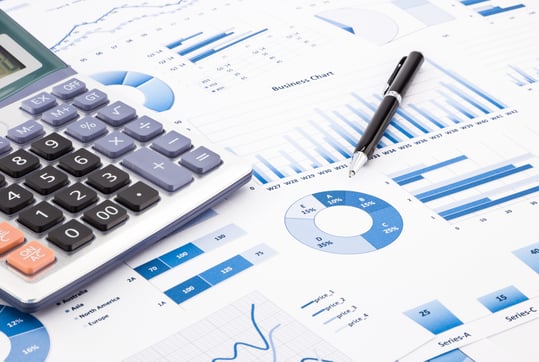The Power of Predictive Analytics for Your Shipping Operation
Big data. Artificial intelligence. Machine learning. Predictive analytics. Like many business buzzwords, these terms have been so overused, and so often misused, they’ve lost some of their impact. That’s unfortunate, because the actual concepts these terms describe — particularly predictive analytics — can offer significant bottom-line benefits to the businesses that learn to use them effectively.
This post will discuss the power of using predictive analytics to make smarter decisions in your shipping and order-fulfillment processes, which can help your company:
- Predict demand
- Improve margins
- Optimize carrier relationships
- Improve delivery times
- Reduce shipping costs
- Reduce fulfillment costs
- Reduce damage
- Identify weaknesses (and strengths) in the supply chain
What is predictive analytics?
Intel Corporation has a helpful metaphor to explain traditional data analytics and business intelligence: These disciplines let you look through the rear-view mirror to get a clear visual of your company’s historical trends and milestones.
But while traditional analytics helps your company see what’s already happened, predictive analytics adds another layer to that intelligence — to help you look forward and forecast potential future outcomes.
Sticking with Intel’s metaphor, while traditional data analytics helps you see clearly through your rear-view mirror, you can think of predictive analytics as providing you a reasonably clear front-windshield view of the road ahead (with only a minimum amount of bug splatter to obstruct your vision).
To cite just one real-world application, consider your credit score. As the IT consulting firm CGI Group explained in its paper on the use of predictive analytics in enterprise decision-making, lenders were among the early adopters of predictive analytics — which they used to build a highly accurate predictive model for assessing risk in loans: the credit score.
Is the credit score a perfect method of predicting bad loans? Of course not. If it were, there would be no bad loans. But by analyzing and constantly learning from the massive amount of financial and behavioral data each of us generates in our daily lives — and by continually refining their algorithms based on these learnings — data scientists have made the credit score demonstrably more accurate than human judgement in lending decisions. And of course, because it’s automated, the credit score is also a far more efficient decision-making tool than human judgment.

How can predictive analytics help your shipping processes?
When the Harvard Business Review ran a feature in 2016 — “Where Predictive Analytics is Having the Biggest Impact” — it reported that most organizations are using these solutions for front-end initiatives like improving their sales and marketing efforts. The paper points out, for example, that businesses are using predictive analytics to more accurately predict customer demand, and to help them find the optimum prices for their products.
But the HBR feature also explains that predictive analytics tools are being used to improve organizations’ supply chains and other backend operations.
It’s understandable that most businesses deploying a predictive analytics solution would focus first on revenue-generating initiatives, like boosting sales. But a business interested in predictive analytics should not overlook such a solution’s ability to help streamline its backend operations as well.
The ability to apply predictive analytics to your shipping processes, for example, can help your company save significantly on your shipping operation’s hard and soft costs — many of which you might not even be aware your business is incurring.
As we pointed out in a previous post, 20% of a company’s shipping costs are soft costs — the less-obvious but no-less-real costs to a business that its shipping operations generate. (These could include error and returns processing, for example, or accounting-department resources required to reconcile inaccurate carrier invoices. Read our detailed overview of soft shipping costs.)
Because most companies do not accurately track, analyze or even understand all of their shipping costs, shipping represents a significant opportunity for many businesses to deploy predictive analytics to identify ways of streamlining processes and saving money.
Indeed, when ShipHawk examined the hundreds of shipping-dependent businesses we work with, we discovered that 95% of these companies were missing opportunities to save real money in their shipping operations because they were using suboptimal processes.
Now let’s look more specifically at how and where predictive analytics — when deployed correctly, such as through ShipHawk’s Transportation Management System — can help a business’s bottom line.

Applying predictive analytics to shipping
The CGI research paper points out that for predictive models to be effective, they need data — lots of it. And although most organizations and most processes can benefit to some degree from predictive analytics, the paper argues that there are certain circumstances where this form of modeling can be particularly useful.
As you’ll see below from the examples that the paper lists as optimal conditions for predictive analytics, they each describe characteristics of the typical company’s shipping operation.
1. Predictive analytics can work extremely well for processes requiring a large number of similar decisions.
Think of your shipping operations. For every order that requires a package to be delivered, your warehouse or distribution-center teams need to make a very similar set of decisions: which box or envelope to use; which packing materials to include, and how much of it; which carrier to select, and what service level to opt for from that carrier; how and when to pull the item(s) from the shelves; how and when to generate the shipping label, return label and other paperwork, how and where to stage the package for carrier pickup, etc.
Applying predictive analytics to these steps can help your company make better-informed decisions — for example, the best box to select to ensure you pack the order safely while still getting the best carrier rate — at just about every one of these steps.
2. Predictive analytics can be highly valuable in situations where the outcomes have a significant impact — for example, where it can save a business a lot of money.
Consider all of the steps required to complete your company’s order-fulfillment process — from the moment it comes through, until the package has been delivered and your accounting team has reconciled the carrier’s invoice.
When you realize how much shipping and order fulfillment can impact so many departments across your company — not only your warehouse but also sales and marketing, customer service, finance, and other teams — it becomes clear that any business intelligence you can use to streamline and improve those process can save your business a lot of money.
This is another reason a predictive-analytics solution can be particularly well-suited to your shipping operations.
3. Predictive analytics can be particularly useful when there’s a lot of available electronic data the system can use to measure outcomes and base decisions.
Think about how many pieces of highly useful data comprise even the simplest order-fulfillment transaction — say, a customer who places an order for two items through your eCommerce site. The data involved in that transaction will include, just to cite a few examples:
- The weight of each item
- The physical dimensions of each item
- The combined weight and physical dimensions of both items
- The package options for the items — box, envelope, palletizing services, etc.
- The options for packing materials to include in the package
- The carrier your team selects (and why)
- The carriers in your network your team chooses not to select (and why)
- The service level your team chooses for shipping the order (and why)
- The cost of the carrier’s tariff
- The carrier’s staging and pickup requirements (e.g., their linear-foot rule)
- Whether the items are delivered on time
- Whether the customer complains they received the wrong order
- Whether the customer complains one or both of the items arrived damaged or broken
- Whether your accounting team deems the carrier’s tariff as accurate

Few businesses — even those that ship dozens or hundreds of orders every day — have a system in place for pulling together and analyzing all of this valuable information. Often the data are spread across many different systems, across several departments in the company.
But if you were tracking all of this information and had a system in place to analyze it, you’d gain a lot of insight about where your company’s shipping processes were breaking down —where mistakes were taking place most often, which types of boxes or other packaging materials were most likely to result in damaged shipments, which carriers were most likely to be on time and which were most likely to surprise your company with last-minute charges, etc.
Now imagine you were able to apply predictive analytics to the mix — to take all of this data and use it to build a predictive model that could, on the fly, help you make the best decisions at every step in the order-fulfillment process to streamline operations, reduce mistakes and waste, and save your company money.
This is why shipping and order-fulfillment are among the best places to start applying predictive analytics in your company. There’s so much additional profitability you could be pulling out of those processes, with just a little help from the right predictive modeling tools.
Want to learn how to apply an automated predictive-analytics system to your shipping operation? Speak with an expert today.
